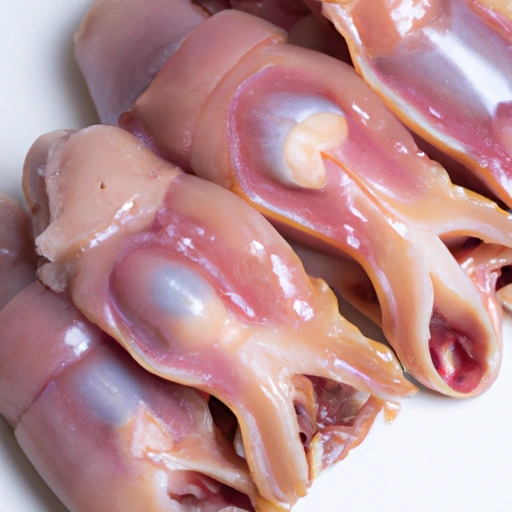Gizzard
Description

Gizzard refers to the muscular stomach of birds, reptiles, fish, and some insects. This organ is used by these animals to grind up their food, often with the help of ingested stones or grit. In culinary contexts, especially when talking about poultry, the term 'gizzard' usually refers to the edible organ from a chicken, turkey, or duck. Gizzards are a popular food item in many cultures around the world and are known for their distinct texture and flavor.
Common uses
Gizzards are commonly used in a variety of dishes worldwide, including soups, stews, and as a protein-rich snack. They are often considered a delicacy and can be prepared in numerous ways to bring out their unique taste and texture.
Nutritional value
Calories
A 100-gram serving of gizzard contains approximately 153 calories (640 kilojoules).
Protein
Protein content is high, with about 31.8 grams (1.12 oz) per 100 grams of gizzard.
Fat
Gizzards are relatively low in fat, providing around 3.1 grams (0.11 oz) per 100-gram serving.
Carbohydrates
Carbohydrates are negligible in gizzards, with less than 1 gram (0.035 oz) per 100 grams.
Vitamins
Gizzards are a good source of certain vitamins, particularly B vitamins like niacin and vitamin B12.
Minerals
They are also rich in minerals such as iron, zinc, and phosphorus.
Health benefits
Gizzards are a lean source of protein and are low in fat, making them a healthy choice for meat. The presence of iron and zinc contributes to the maintenance of a healthy immune system and energy metabolism. Additionally, the B vitamins found in gizzards play a vital role in brain health and maintaining optimal body function.
Potential risks
As with any organ meat, gizzards should be consumed in moderation. They can be high in cholesterol, so those watching their cholesterol levels might need to limit their intake. It's also important to ensure gizzards are thoroughly cooked to avoid the risk of foodborne illness.
Common recipes
Gizzards are often used in traditional recipes such as gizzard stew, gizzard soup, and fried gizzards. They are also a popular addition to stuffing and gravy recipes during holiday seasons.
Cooking methods
Common cooking methods for gizzards include braising, boiling, grilling, and frying. Gizzards can be tough, so slow cooking methods are often employed to tenderize the meat.
Pairing with other ingredients
Gizzards pair well with robust flavors like garlic, onions, and herbs such as thyme and bay leaves. They also complement acidic components like tomatoes or wine that can help to tenderize and flavor the meat during cooking.
Summary
Gizzards are a versatile and nutritious ingredient that can add depth and flavor to a variety of dishes. With high protein content and a range of vitamins and minerals, they offer several health benefits when consumed as part of a balanced diet. Whether stewed, fried, or grilled, gizzards provide a unique culinary experience that is appreciated in many cultures around the world.